#Article to read about 3D model
Explore tagged Tumblr posts
Text

Formidable
Pairing: Oscar Piastri x Felicity Leong-Piastri (Original Character)
Summary: Andrea Stella figures out that Felicity Piastri is more than “just” Oscar’s wife.
Notes: Big thanks to @llirawolf , who listens to me ramble and checks my science-y mumbo jumbo 😂
(divider thanks to @saradika-graphics )

It started the way most breakthroughs did—not with a groundbreaking discovery, but with a tired engineer holding a half-wrinkled printout and a hopeful expression.
“Boss,” James said, hovering just inside the doorway of Andrea’s office. “I think you should read this.”
Andrea looked up from his laptop. “If it’s another CFD model from that Reddit forum, I swear—”
“It’s not. It’s from a paper. Academic. Legit. Published in Race Systems & Applied Motion last month.”
Andrea raised an eyebrow. “Obscure.”
“Very. It has like 20 readers,” the engineer agreed. “But I think it’s real. It’s clean. It’s sharp. It’s…” He hesitated. “We might want to test it.”
That got Andrea’s attention.
He took the paper and began to skim.
Title: Redefining Compliance: Adaptive Suspension Geometry Under Load-Sensitive Parameters for Mid-Field Chassis Configurations.
Andrea kept reading. It was dense—academic, yes—but it was also practical. It spoke the language of someone who knew exactly what they were doing. There were no ego traps. No unnecessary complexity. Just hard math and hard-earned insight.
Andrea flipped the page. Then another. His eyes caught a note referencing flex dynamics in chassis response curves and passive recovery lag.
It was correct. More than correct. It was insightful.
The author wasn’t spitballing ideas from afar—this was the work of someone who had lived in the theory and understood the application. Who referenced real-world tolerances. Racing examples. The math was sound. The diagrams were better than half the ones their CFD team managed.
Andrea flipped back to the byline.
Dr. F. Piastri.
Piastri.
James grinned. “Fun coincidence in the name, right? He’s smart.”
Andrea didn’t correct him.
Because yes—coincidence. Probably. But something about it stuck in his brain, like a whisper he couldn’t quite place.
He read the essay in full that night—twice. It was elegant, sharp, and frustratingly precise in the way only truly experienced voices ever were. The type of clarity that came from years of not just understanding a concept, but translating it into reality.
The next morning, Andrea sent out an internal email.
Subject: Additional Works by Dr. F. Piastri If anyone has access to prior publications by this author, please forward them to me.
By the end of the week, his inbox was full.
One essay became three. Three became eleven. Eleven became twenty.
Each one published under the name F.Piastri, buried in obscure journals and small-circulation engineering reviews that didn’t get traffic unless someone was either deeply curious or incredibly desperate.
Andrea was both.
Each article was smarter than the last—strange, elegant engineering thought-pieces published across the most obscure academic mechanical journals Andrea had ever encountered. Niche ones. The kind that only the most obsessive minds contributed to, with names like Thermoelasticity in Microstructured Materials and Lateral Load Adaptation Quarterly.
F.Piastri had written:
An article about Load-dependent understeer in transitional corners (with math that Andrea double-checked twice because it was too clean).
A 2019 think-piece on long-run stability under thermal degradation.
An essay about Aerodynamic oscillation buffering for short-track endurance vehicles.
An article about the economic viability of 3D printed carbon struts under rotational shear (he actually flagged that one for McLaren Applied).
A thesis that corrected a widely accepted torque model—buried in a conference archive.
A published rebuttal in Journal of Vehicle Design so politely worded it read like a love letter—until you realized she’d rewritten the reviewer’s assumptions line by line.
There was even one article on fluid dynamics that had been cited in a grad-level textbook from ETH Zurich.
Andrea devoured them all.
He—She?—wrote like someone who saw the car before it was built. Who understood not just how suspension worked, but how it felt. How energy passed through a chassis not as force but as intent.
The writing style was sharp. Practical. Absolutely ruthless in its logic. There was clarity there—an elegance—that reminded him of only a few people he’d ever worked with.
It was revolutionary. It was poetic.
By the time he tracked down the doctoral thesis from Oxford, Andrea wasn’t breathing properly.
Reinforcement Through Flexibility: Dynamic Adaptation in Composite- Structured Performance Environments.
By: F. Piastri.
Submitted: December 2022
Andrea stared at the name.
F. Piastri.
He stared for so long his tea went cold beside him.
His hands were shaking—not because of nerves, but because he already knew.
He opened the PDF. Skimmed past the table of contents. Scrolled through diagrams that made his heart stutter.
There was no photo. No biographical section. Just a clean Oxford University seal, 284 pages of dense, brilliant theory, and then—
A dedication.
To Oscar: For believing in a future that didn’t exist yet, and building it with me anyway. Every lap, every choice, every time—you’ve been my constant.
And to Bee: For reminding me that softness and strength aren’t opposites. You are the best thing I’ve ever helped create.
Andrea sat back in his chair like he’d been physically shoved.
Bee.
Oscar.
F. Piastri.
Felicity Piastri.
Felicity.
Oscar’s wife.
Dr. F. Piastri wasn’t some reclusive academic or distant uncle with a gift for simulation modeling.
She lived in Oscar’s house.
She packed his lunchbox.
She raised their daughter.
And she had published papers on suspension theory that half of F1 would kill to understand. Quietly. Efficiently. Correctly.
Andrea leaned back in his chair, stared at the ceiling for a long moment, and whispered:
“…Of course it’s his wife.”
Of course the quiet, composed driver who rarely raised his voice and always had one hand on the bigger picture had married someone brilliant. Of course she wasn’t just talented—she was a published expert with a doctorate from Oxford.
Not a coincidence.
Not a mystery engineer.
Not some guy.
But Oscar’s wife.
Oscar Piastri—quiet, methodical Oscar—had married a genius.
A doctor of mechanical engineering from Oxford who wrote better technical documentation in a margin note than most engineers did in a year. Who published under initials. Who could probably solve half their handling inconsistencies while holding a toddler on her hip.
Andrea sat in silence for a full minute.
Then he exhaled. “...of course he did.”
He opened a new tab.
Email draft:
To: Technical Team
Subject: URGENT – Reference Reading Required Attached: Every single thing Dr. F. Piastri had ever published.
***
The meeting was meant to be quick.
Just a routine Monday touchpoint—debrief, run through media notes with Sophie, talk sponsor appearances, maybe discuss Oscar’s upcoming comms obligations.
Zak had rolled in with a protein shake.
Lando was lounging sideways in a chair like he’d melted into it.
Oscar had a protein bar and an expression of polite mildness, as usual.
Andrea, meanwhile, had not slept.
Not because of the race.
Because he’d spent the entire weekend reading Dr. Felicity Piastri’s entire body of work. Every published paper. Every obscenely niche journal article.
And her doctoral thesis.
He hadn’t meant to do it all in one sitting. He just couldn’t stop.
By 2 a.m. he was muttering things like “Of course she used Euler-Bernoulli assumptions, she’s too smart for non-parametric bullshit.”
By 4 a.m., he’d highlighted her proposed solution to dampen micro-vibration load in corner exits.
By 6 a.m., he had a headache, an existential crisis, and a desperate need to know: Why had Oscar Piastri never mentioned this?!
So at the end of the meeting—just as Sophie was wrapping up and Lando was aimlessly spinning a pen like a propeller—Andrea set down a file on the table.
Calmly. Casually. Like he hadn’t just had his entire mechanical worldview rattled by a woman who wasn’t even on the payroll.
“Oscar,” Andrea said, voice deceptively neutral. “Why didn’t you ever mention that your wife holds a doctorate in mechanical engineering?”
Oscar, halfway through eating his protein bar, blinked. “What?”
Andrea gestured vaguely, as if the thesis were still radiating brilliance from his desk. “Felicity. Doctorate. Thesis. Dozens of published papers. Half of them useful to our current car design issues. Why didn’t you say anything?”
Oscar blinked once. “Oh. Yeah. She gets bored sometimes.”
Andrea blinked back.
Lando stared like he’d been smacked with a front wing. “Wait—she got a doctorate?!”
Oscar nodded, chewing. “Yeah. Finished it in 2022. She was stuck in that horrible flat in Enstone while I was back and forth with Alpine, and she got bored. Wrote most of it at the kitchen table while Bee napped.”
Andrea just… stared.
He had read the thesis. Studied it. The mathematical modeling alone had kept him awake at night—and she had apparently written it during toddler nap times, while stuck in a damp shoebox flat in Oxfordshire.
Zak looked up slowly from his tablet. “Your wife was bored. So she got a PhD in mechanical engineering.”
Oscar shrugged. “She already had the research mostly done before Bee was even born in 2020. She just had to write it up. Bee was napping a lot anyway.”
Sophie blinked. “She wrote a 200-page dissertation with a toddler in the house?”
Oscar just shrugged. “It helped that Bee liked the sound of the keyboard.”
Andrea turned to Zak, still stunned. “She predicted the kind of high-frequency oscillation we’re seeing this season. Two years ago. In a footnote.”
Lando leaned forward like he was watching a live feed of someone discovering aliens. “She’s just, like, a genius?” he asked, voice too loud, too incredulous. “And you never brought it up?”
Oscar just sighed. “She hates that word.”
Andrea just stared at him. “Oscar, she’s not just good. She’s formidable. Has she ever applied anywhere formally?”
Oscar looked genuinely confused. “Why would she apply anywhere?”
Andrea stared. “To work. In engineering. In motorsport. Academia.”
Oscar blinked. “She does work. She manages our lives, Bee, the house, and the chickens.”
Lando leaned toward Andrea, wide-eyed: “I’ve never felt dumber in my entire life.”
Andrea sighed. “Join the club.”
***
The kitchen smelled like vanilla and wood polish and faintly like chicken coop — which meant Felicity had mopped and baked and wrangled Mansell, the escape artist hen, all while probably rebalancing one of their stock portfolios.
Oscar dropped his bag by the door and leaned against the kitchen entryway.
Felicity was sitting at the table in her old university hoodie, feet bare, Bee curled up under her arm asleep with Button the frog as a pillow. There were spreadsheets open on one side of her laptop screen, a half-watched nature documentary on the other, and one of Bee’s plastic toy bulls standing solemnly in the middle of the table for reasons unknown.
He smiled.
God, he loved her.
“Hey,” he said softly.
Felicity glanced up. “Hey. Dinner’s in the oven. Bee passed out mid-pie crust.”
“Excellent,” Oscar said, dropping into the chair beside her. “Because I need carbs.”
She raised an eyebrow, equal parts amusement and curiosity. “Bad day?”
“No. Just... intellectually humbling.”
Felicity made a low amused noise and went back to her laptop. “Did Lando try to explain crypto again?”
Oscar snorted and reached over to carefully lift Bee into his lap, her curls warm against his hoodie. She barely stirred.
He could have let it sit. Saved it for later. But it was buzzing under his skin.
“Stella read your papers.”
That got her attention.
Felicity paused, her fingers stilled mid-scroll. “Which one?”
“All of them,” Oscar said. “Apparently it started with one of the engineers, who brought an article in from Race Systems & Applied Motion. Then he spiraled.”
“Ah,” Felicity murmured, unsurprised. “That one had a good diagram.”
“He found your thesis,” Oscar added.
This time she didn’t answer right away.
He reached for one of Bee’s crayons and twirled it idly in his fingers, watching her.
“He read the dedication,” he said, voice quieter now.
Felicity’s eyes softened in that way that always undid him a little. Always had.
“Did he say anything?” she asked.
Oscar smiled faintly. “He said you’re formidable.”
There was a beat of silence.
Then Felicity laughed—not loud, not startled, just warm and wry and a little disbelieving.
“God help the man,” she said. “He must have hit the rebuttal piece from the Vehicle Design Journal. That one made a few engineers cry.”
Oscar grinned. “Yeah, well. He was halfway to building you a shrine by the end of the meeting. I also told him you got bored in Enstone and wrote your PhD while Bee was napping.”
Felicity gave him a look. “You make it sound like I was scrapbooking.”
“Weren’t you also doing that at the time?”
Felicity blinked. “...Okay, fair.”
Bee stirred slightly in his lap, a tiny sigh escaping her lips as she nuzzled deeper into his hoodie sleeve.
Oscar looked down at her—this tiny human they somehow made and raised—and then back at the woman across the table.
Her hair was messier than usual, strands escaping her braid, and there was a faint flour smudge near her temple. She hadn’t bought herself a new pair of jeans in two years. She sometimes forgot to eat when she was buried in simulations. She once fixed the bathroom plumbing at midnight because she didn’t like how the guy from the hardware store spoke to her.
She was the smartest person he knew.
Oscar knew most people wouldn’t think it when they first met her. She smiled too easily. She didn’t correct anyone. She let others assume things—that she was just the girlfriend, just the wife, just the mother.
But she had a doctorate from Oxford, and more published academic papers than most career professors. She could hold court with race engineers and theoretical physicists in the same breath, then go home and teach Bee how to build a pulley system out of Lego and twine. She spoke in quiet, exact terms, and when she challenged people, she did it so gently they sometimes didn’t notice until it was too late.
He’d long since stopped being surprised by her. He’d just—normalized it. Integrated it. Felicity being a genius was like oxygen to him: invisible, essential, and easy to take for granted until someone else nearly passed out from the realization.
She was just Fliss to him.
The woman who sold her designer bags to pay rent when her family cut her off. The mother of his child. His fiercest critic and his most devoted supporter. The one person he trusted without hesitation.
She didn’t want headlines or praise. She wanted quiet mornings and clever puzzles. She wanted Bee to grow up confident. She wanted Oscar to remember to eat something green.
She was the smartest person he knew — and she hated being called smart. So he didn’t. He just came home.
“He called you formidable,” he repeated. “And I agree. For what it’s worth.”
Felicity smiled then—slow and quiet, the kind that reached all the way to her eyes.
She leaned across the table and kissed his temple. “Thanks,” she said. “But if he asks me to consult, I’m charging him triple.”
Oscar laughed softly and ran a hand through Bee’s curls. “Deal.”
And he meant it. Because maybe it was easy for him to forget sometimes, tucked into the quiet rhythm of their life, that the world hadn’t caught up to how brilliant she was.
But he never stopped being proud of her.
Not for a second.
#formula 1#f1 fanfiction#formula 1 fanfiction#f1 smau#f1 x reader#formula 1 x reader#f1 grid x reader#f1 grid fanfiction#oscar piastri fanfic#oscar piastri#Oscar Piastri fic#oscar piastri x reader#oscar piastri imagine#op81 fic#op81 imagine
1K notes
·
View notes
Text




Round 2 - Simblr's Saddest, Wettest Meow Meow - Mainline
No. 27 (@literallyjusthereformods) VS. Andre St. Fleur (@armoricaroyalty)
(polls are presented left -> right unless stated otherwise)
Who's sadder? Who's wetter? Read on for more information, and vote with your heart!
What is a ‘Meow Meow’?
(taken from tumblr user @/torturelabyrinth) “The thing about a true poor little meow meow is they have to be 1) downtrodden 2) morally questionable at best 3) deeply and pathetically miserable”

No. 27
Alias: "Livard"
No. 27 was the 27th 'living' instance of the Crane Foundation's modern Quintessence Program. When the breach occurred, 27 took immediate opportunity to leave, using her sharp limbs to grievously wound operatives and other personnel who attempted to obstruct her path of escape. Eleven confirmed aggravated fatalities. An unknown number of fatalities occurring at trample areas and exit pileups. She proceeded to use the slaughter-path of the other breachers as a clear line out of the facility’s underground portion, ascending rapidly to the upper floors where she is believed to have fled the building.
As of right now, 27 is an immune carrier of a new strain of the same pathogen currently causing a cataclysmic outbreak. While typical variants can only infect and alter biological matter, this mutation was observed with the new ability to infect machines during controlled testing.
No. 27 was last spotted wearing the stolen cardigan of Dr. Livard, with a secondary article of clothing tied beneath at the waist. The owner of the second article has not yet been identified.
27 has been reported self-identifying as ‘Livard,’ and has not discarded the nametag attached to the stolen cardigan, despite having no reason to keep it.

27 was created as an experimental binding of biological tissues and cybernetics. Unlike precursors, who were constructed with biological matter on a 75% or higher percent mechanical endoskeleton, 27 was an experimental integration of traditionally classified ‘biological’ and traditionally classified ‘mechanical’ elements on a fundamental level. The use of nanites in her tissues, along with algorithmic adaptations, created a unique combined system challenging the preconceived definitions of the categories.
However, the arise of the new pathogen strain saw 27 strictly confined. 27 was shown to be incredibly observant of those observing her, and an incredibly accurate mimic of their behaviors. She, notably, engaged in a game of rock, paper, scissors with an anonymous researcher after they and their coworker demonstrated the game through the window.
Sentient or not, 27 still falls outside of the Mimic Law, and is legally property of the Crane Foundation. With artificial sentience having already been academically accepted years ago, whether 27’s curiosity is dictated by script or by consciousness is not our concern.
As for the present times, it was assumed 27 would perish shortly after leaving the facility, without the specific needs of her body being met in a controlled environment. Our assumptions were wrong. 27 has been spotted feeding on mechanical devices as if they were prey animals. We can only assume this habit will accelerate the spread of the new pathogen strain, and while we would like to reclaim 27 for study, it might become necessary to terminate her entirely to prevent escalation of the already dire world situation.
Originality Status: 100% Original Property of the Crane Foundation
Additional Notes:
(Attached below is a fabricated 3D model based on the last contained recording of 27. It is merely for visual context. If you are an operative searching for 27, or, in some inexplicable instance, creating a poll (Tom), please use the topmost image as it is the most up-to-date.)


Andre St. Fleur
What makes him a Sad, Wet Meow Meow? Born to royalty but completely temperamentally unsuited for it, Andre is pathetic and sad and weak-willed and a big, giant loser. He's the king of a small and unimportant country, and he simply cannot parent effectively or stop cheating on his wife. Finally forced to decide between his mistress and his wife of nearly 30 years, he became so paralyzed with indecision that he developed a terminal illness instead, saving him from ever having to make up his mind about anything.
Just some additional pictures of Andre moping, crying, and letting his loved ones down </3





I think my boy has the potential to go far, but even if he gets knocked out in the first round...what could be sadder, wetter, or more pathetic than getting immediately eliminated from the "most pathetic" tournament?
17 notes
·
View notes
Text

Exector
This article is part of our Japanese Obscurities feature. We put out a whole book about them, which is available as both a full color hardcover and a Kindle ebook from Amazon! If you’d like to see more of these features, please check out the book and if you enjoyed it, leave a five star review so we can do a follow up with even more interesting, offbeat, or historically important Japanese games!
Exector is notable for being the first original game developed by Arc System Works and the first to have Guilty Gear creator Daisuke Ishiwatari credited on it. He’s listed under “3D Modeling Assistant Designer”, but Ishiwatari himself says that his role was limited to drawing characters for the game’s homepage and a bit of debugging. Despite this, Exector exhibits some of the defining qualities of Guilty Gear’s first installment, such as multiple references to rock bands and gameplay that’s unpolished but endearing.
Read more...
#exector#arc system works#playstation#action games#japanese video game obscurity#mecha#sci fi#hardcore gaming 101#steven barbato#feature#japanese obscurities#review#video games
17 notes
·
View notes
Text
Day #4338
for today's post, I was thinking I should update everyone on my activities concerning rhythm thief for the past two years. I'll be spilling my monster truck of an essay filled with my thoughts and concerns (embarrassing) so I'm putting it beneath the cut 🤧
I haven't been able to work on RT as much as I would like to as compared to two years ago. I got really depressed to the point I couldn't go outside for months, then I got a part-time job for two months last summer, and I also reinstalled a game so that fandom's been at the forefront of my brain for the past two years. also, I started graduate school, and I'm on track to graduate by the end of this year!!! so honestly I've been giving my all to a different fandom's wiki work and my studies... and thankfully I'm happier now!! and then at some point, I will have to get my first big girl job 😭😭😭 praying someone will hire me 🙏
and then as for my rhythm thief activities, I don't know, sometimes I feel like I should be releasing the content all properly and beautifully packaged, especially since I'm not halfway done with some things. I don't like showing off my incomplete work I guess? but then today I realized that I should probably share what I'm doing so y'all know I'm not purposefully gatekeeping things or... I don't know (paranoid)
that said, here's a non-exhaustive list of things I have been working on or plan to do:
datamining ET and PC. I've been working on and off since 2020 with nicole and zai, two of my besties who have also lent a hand in researching datamining methods for images, audio, video, text, and working with the 3D models in both games. I want to somehow have the paris model viewable on the RT wiki using the interactive map function
this is moreso nicole's hard work, but once in a while, we're slowly uncovering/recovering RT materials like magazine article scans and TV interviews. it's quite difficult to track down magazine scans since we'd most likely need to buy some off resellers, and they're 10-year-old content so it's hard to track down...
tangentially related, I connected with a programmer acquaintance of mine and they helped me decode the entire PC text in Japanese, and I'm super excited to read it. I have plans to make a sort of story viewer site where you can select if you want to read the official EN translation, my translation, and the original JP text, complete with sprites, backgrounds, and text boxes. I wanted a nicer alternative than on the RT wiki, where the official EN script is up currently
about translations, I've been working on subtitling the ~24-minute TV special. I have the JP script done (with help from a Japanese friend) and timing done, but I just need to actually finish translating. I think I have about 1/2 done. I'm currently considering finding a proofer so that hopefully I will feel more assured about my work when it's done. it's tough getting the motivation to translate, but I really want to put out my best work possible for RT through accurate translations. I've seen what inaccurate/machine translations have done to create misunderstandings/the spread of misinformation in other fandoms, and yet I've been taking so much time... I feel guilty for sitting on so much content I want to go through but I often can't go through with it unless I feel up for it (which is rare) and I'm also terribly picky on my work so I like to translate things by myself (and leave proofing to another person). I'm sorry for being so complicated about this 😭
I said it last year, but I've been wanting to update my blog's theme to more accurately match it as an RT info hub in addition to counting the days until the sequel releases gimmick. I want to make the RT translations I release easily accessible, but I think I've been slacking on this because I feel I don't have much (multiple large projects) to showcase just yet
finally, for the RT wiki. I have plans to get back into editing for the RT wiki and I'm currently collaborating with some other trusted editors in various standardization and appearance improvements. unfortunately, I don't think I have enough time to tackle writing content for all pages... if anyone seriously would like to help describe characters and their actions in the main plot, locations, or anything else you think should be improved, please!! by all means, edit the wiki!!
I plan to host an RT 15th anniversary project in 2027 where fan works will be displayed on the TSX billboard in times square. I also want to release another RT doujin/zine again, but my JP friend and I are too busy to plan something concrete
if you scrolled to the bottom for the tldr, I think I often try and perfect things on my own, which is why it takes me so long to work on things... (also I'm like super picky, I guess that's the perfectionist in me). I have so many plans like translating this, subtitling that, releasing this datamined content, updating the wiki, participating in RT fan projects... it's a lot to balance when my mind is elsewhere and I've been feeling guilty and ashamed to admit it 😭
the other fandom that's been occupying my mind has taken up much of my brain space, and I'm thinking it might be healthier to cut back and refocus on RT, my main beloved fandom again, but it's a bit difficult since I have made myself a reliable figure in that fandom's wiki team 🤧 tbh I think I might have au/adhd or something cause wow..... I sure sound like it with my strong fixations and difficulty finding motivation (even though RT's the thing I love the most in my life)
I want to draw!! translate!! wiki edit!! do anything and everything for RT!! it's been massively difficult for me for years and I'm sharing my frustrations with you all 😭 before I knew it, so many years have passed and I have barely released anything. I hope no one thinks of me any lesser, but I thought it would be good to share my thoughts, my goals, and my passion with my followers since I think I'm more than "just that one person who's been running an RT gimmick blog for over a decade" !!! that's all!!! thanks for reading!!! 🥹🥹🥹
20 notes
·
View notes
Text
Gamera Returns! Yuji Saka Leads the Revival of the 1996 Classic
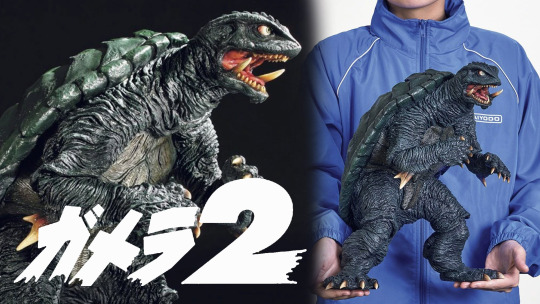
In a move that has kaiju fans buzzing with excitement, renowned designer and modeler Yuji Saka has taken the helm to revive Gamera 1996 (G2), one of the most beloved installments in the franchise’s history. The announcement was made earlier this week, sparking speculation about what this new production will bring to the legendary Guardian of the Universe. Saka, best known for his meticulous craftsmanship and deep knowledge of Japan’s kaiju legacy, is set to breathe new life into the iconic 1996 film, Gamera 2: Attack of Legion. While details remain under wraps, industry insiders suggest that the revival will involve a mix of cutting-edge technology and practical effects, staying true to the franchise’s roots while modernizing its appeal.

The original model was digitized using the latest 3D scanning technology, and the overall height was increased from about 19 cm to about 32 cm. In addition, the mold was created directly by baking the output from a 3D printer, and the characteristics of the original model were reproduced as faithfully as possible under the complete supervision of Yuji Sakai. Yuji Sakai also thoroughly supervised the coloring. The painting process was also carefully done, and the finished product looks like a one-off work. This is a masterpiece that even non-Gamera fans cannot miss, and it can be called the "ultimate Gamera." The 1996 film, directed by Shusuke Kaneko, was a landmark entry in the Gamera Heisei trilogy, praised for its special effects, compelling narrative, and dynamic kaiju battles. Its legacy has endured for nearly three decades, with fans frequently ranking it among the greatest kaiju films ever made. Saka’s involvement raises questions about whether this revival will be a full-fledged remake, an enhanced re-release, or something entirely new. Given his experience working on various high-profile tokusatsu and kaiju projects, expectations are high that he will deliver a visually stunning and emotionally resonant experience. Fans of the Gamera franchise eagerly await further announcements, with many hoping for a theatrical release or streaming availability that will introduce the film to a new generation of kaiju enthusiasts. One thing is certain: with Yuji Saka at the helm, Gamera 1996 (G2) is poised for a spectacular resurgence. This item will be released on December 31, 2025. link Stay tuned as more details emerge about this highly anticipated return of the Guardian of the Universe!

Read the full article
4 notes
·
View notes
Text
[Interview TL] 4Gamer’s Weekly VTuber Files #29 - Minase Rio
Source

Name: Minase Rio Company: Holostars (UPROAR!!) Streaming platform: YouTube SNS: X (Twitter) Hashtags: Live #燐央顕現中 / Fanart #燐央絵 / Clips #お試し燐央 Character/Model designer: KEKI Debut Date: March 30th, 2022 Birthday Date: July 26th Height: 170cm Introduction: "You can see me too? This place is quite lively and fun, it's where I truly belong." A ghost who previously died carrying his determination to be an idol. Since then, he has spent the days lingering around, but Fuma's invitation made him walk toward the path of an idol once more. He doesn't like scary things and ghosts beside himself.
10 QUESTIONS FOR VTUBERS
Q01. Tell us your main (streaming) content! I mainly do singing and gaming streams! For singing, a lot of the songs I picked are pretty uncommon for male singers because they often use high-pitched tones! As for gaming stream, when I was still alive I grew up in a household that rarely gives me the opportunity to play games, so now I'm using all the time I have now to experience different kinds of games! I especially like those that focus on the storyline.
Q02. What was the cue that kickstarted your streaming activity? When I became a ghost out of nowhere, I received an audition invitation from my then-genmate Yatogami Fuma!
Q03. Please recommend us your “newcomer’s friendly” videos or stream archive! If you like singing streams then I recommend you to check out my recent 3D live from February this year "Live Without Limits", and my 3D debut live as well! But if you prefer gaming streams, my short horror-game streams and the currently ongoing (as of the writing of this article) streams for Persona 3 Reload are my recommendation! I like to challenge a lot of things like collabs and stuff I've never tried before for this year, so please look forward to any cover uploads too! There are so many things I want to show to everyone…! (lol)
youtube
youtube
Q04. Tell us things that you like or something you’re good at! Related to streaming, I love story-focused games a lot! I started my activity with no prior experience in playing games, so I've been enjoying my time starting all these popular titles for the first time. It's easy for me to feel empathetic towards the stories so oftentimes my knowledgeable viewers (who have played the game) have been kindly watching me through with a smile. Outside of streaming activity, I'm good at cooking! Although rather than making a fancy-looking meal, I'm good at cooking something tasty with whatever ingredients I have! (lol)
Q05. Tell us a hobby or content that has piqued your interest lately! Both of these are manga but I just really wanted to introduce these titles to everyone…! The first one is "Kemonokuni/Beast Country"! It's a gut-wrenching series about a human who becomes a slave to a beast, every character is really charming, and it's a really interesting series that makes you ponder about the feelings of both humans and beasts alike. It's updated biweekly every Wednesday so I've been reading it diligently! The second one is "Omae, Tanuki ni Naranee ka?/Would you like to be a Tanuki?"! I first started reading it because I find the Tanuki cute!! But more than that, the characters who appeared in the series are also as lovely, and the stories are mostly very heartwarming. Some stories are pretty light-hearted and short, but other times you'll find some chapters that allude to the next one with apt foreshadowing which makes you interested in the continuation!
Q06. Is there any VTuber around that has caught your attention? Let us know! If I started talking about all of the seniors and juniors from the same company I'm in, I wouldn't have enough time to introduce them all. So I'd like to introduce someone outside of it or rather, someone that I'm not personally involved with yet… To be honest, recently I've been paying attention to Kannagi Tenri-san. I always like watching streams of people with good singing skills, be it from my seniors/juniors, other companies', or even indies. Among that, I found out about Kannagi-san– not only she is an overwhelmingly skillful singer, but she's also capable of conveying the emotion of the songs in such graceful ways in my opinion.
Q07. What are other things you’re paying attention to other than VTubers? Within the music industry it's Yuuri-san, while in voice acting it's Chiba Shouya-san! I've been a fan of Yuuri-san's songs from the start, and I've probably sung his songs a lot in most of my singing streams already. Even after he became a successful artist, there are various projects done over at YouTube including discovering new-gen talents, as a performer there are many things I could learn from him. I've known Chiba-san after knowing he was cast as the protagonist of a certain game. This opinion comes from my amateur self but, I thought of him as someone who’s capable of bringing the character’s emotion alive, making his performance a marvelous one. It’s also thanks to his wonderful performance that I’m able to find many amazing works!
Q08. Is there a recent thing that left a deep impression on you, and is there anything else you’d like to try out? Since I worked mainly while utilizing my voice, I'd like to challenge myself with other things besides singing! Also, I really like tea so I'd like to have a job where I could introduce various tea variants as well as make my own flavored tea.
Q09. What sort of content you’d like to challenge yourself for now? Maybe performing on a live stage outside of my own company, I'd like to sing in various places! For that reason, I also want to make more original songs!
Q10. Tell us your message to the readers! Thank you to everyone who has been reading up on this part!! If anyone here holds an interest in me after reading this article, feel free to drop by my stream! Besides me, there are also many other Hololive Production talents you can see almost everyday! It makes me happy if you were able to find “someone” who could bring out the colors of your life. Even more if that “someone” happens to be me! (lol)
5 notes
·
View notes
Text
What Materials Are Used for Making Scale Models and Miniature Models?
How AR Model Makers Choose Materials for Stunning Scale Models
When it comes to crafting precise and eye-catching scale models, the materials used can make or break the final product. Whether it’s an engineering model, a marine model, an industrial model, or an architectural model, the team at AR Model Makers knows that selecting the right materials is key to delivering quality. In this article, we’ll explore the materials commonly used by expert miniature model makers like AR Model Makers, how they enhance different types of models, and why they matter to clients across industries. From house models to complex industrial designs, you’ll discover what goes into creating these miniature masterpieces.
Why Material Choice Matters in Scale Model Making
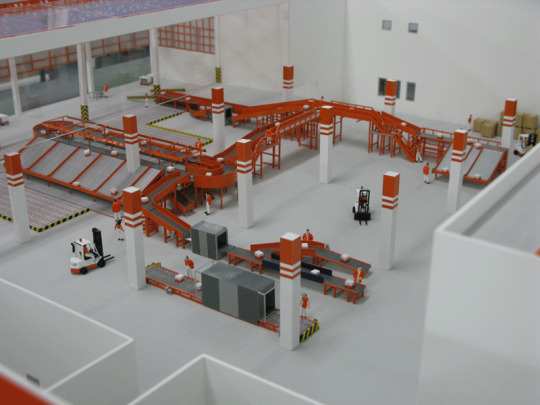
Common Materials Used by Miniature Model Makers
Miniature models come in all shapes and sizes, and so do the materials used to create them. Here’s a breakdown of the most popular choices at AR Model Makers and how they’re applied.
Wood – The Timeless Classic

Acrylic and Plastics – Precision and Durability

Metal – Strength for Industrial and Marine Models

Foam and Cardboard – Lightweight and Cost-Effective
https://armodelmakers.com/wp-content/uploads/2025/03/Foam-and-Cardboard.jpg
3D Printing Resins – The Future of Model Making

How AR Model Makers Tailor Materials to Your Project
Every project at AR Model Makers is unique, and material choices reflect that. For a marine model, they might combine metal for the hull with acrylic for water effects, creating a lifelike display. An industrial model could blend 3D-printed parts with metal accents to highlight machinery. By understanding the project’s purpose—whether it’s a trade show display or a client presentation—AR Model Makers ensures the materials align with both budget and vision.
For instance, a recent house model project in Delhi used a mix of wood and foam to craft a realistic neighborhood layout, earning praise from clients and establishing AR Model Makers as one of the best model makers in Delhi.
The Role of Craftsmanship in Material Selection
Materials alone don’t tell the full story—expert craftsmanship brings them to life. As one of the best model makers in Mumbai and beyond, AR Model Makers combines cutting-edge tools with hands-on expertise. Their team knows how to sand wood to a perfect finish, weld metal seamlessly, or paint acrylic for a polished look. This dedication elevates every engineering model, marine model, or architectural model they produce.
Interested in the process? Learn more about their approach on the AR Model Makers About Us page.
Why Choose AR Model Makers for Your Next Model?
With a reputation as top model makers in India, AR Model Makers stands out for their material expertise and client-focused approach. Whether you need a detailed marine model for a maritime expo or a sleek industrial model for a product pitch, their use of high-quality materials ensures stunning results. Plus, their presence in cities like Delhi and Mumbai makes them accessible to businesses nationwide.
Ready to start your project? Reach out via the AR Model Makers Contact Us page to discuss your vision.
External Resources for Further Reading
To dive deeper into scale model materials, check out these authoritative sources:
The Spruce Crafts: Guide to Model Making Materials
Material Properties for 3D Printing by Formlabs
If you have a project In mind just give us a Call
Have a project in mind? Let AR Model Makers bring it to life with the perfect materials! Drop a comment below with your thoughts, share this post with fellow model enthusiasts, or reach out to the team at AR Model Makers Contact Us to get started.
FAQ
What materials are best for an engineering model?
Materials like acrylic, metal, and 3D printing resins are ideal for engineering models due to their precision and durability, as used by best engineering model makers like AR Model Makers.
How long does it take to build a marine model with AR Model Makers?
Depending on complexity, a marine model can take anywhere from a few days to weeks, with AR Model Makers using metals and acrylics for top-quality results.
#marine model#architectural model#scale model#craft#art#model makers#model making#miniature model#engineering model#scalemodel
2 notes
·
View notes
Text
Astronomics Game Art : Designing Mining Equipment! Pt 3
Oversized Equipment With a base set of equipment solved for Astronomics – demo on steam right now! – there were two things next on the checklist: thinking about colour design, and thinking about some of the equipment that didn't fit into the neat little categories of drilling/pumping/vaccuuming etc.
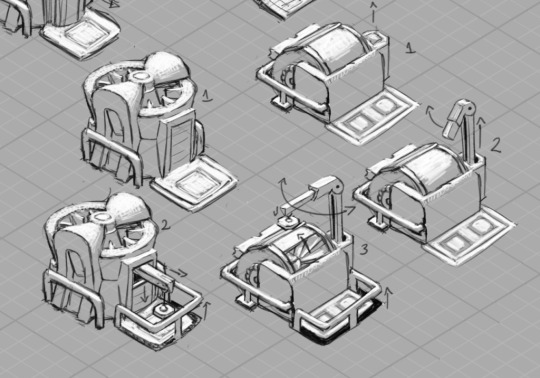
Firstup, we tackled some big ones: one of the things we wanted the player to get to work towards was processing raw materials -- and that meant big processing equipment that could intake entire containers of raw material and spit out something different. These were a really fun challenge to keep in the same design language as our smaller machines while pushing the scale.
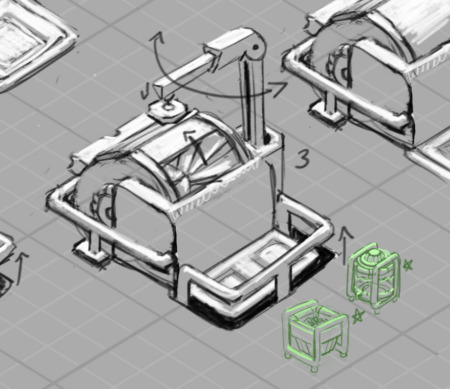
This is one place where our safety-bar themed style really helped -- the ubiquitous bars were very useful as a shared unit of scale between the smaller and larger equipment - and in these early drawings they were a clear warning sign that I hadn't fully measured out the scale relationships: Here you can see the containers, when scaled down to a size where both could fit into that protected area on drawing 3, have safety bars about half or less as thick as the safety bars on the machine. Scale remained something we had to wrestle with and fine tune as we went, and we'll actually come back to the containers in a little bit. The other larger piece of equipment we needed was one that's central to the demo -- the crane! Here you can see a few of the different ideas we were exploring.
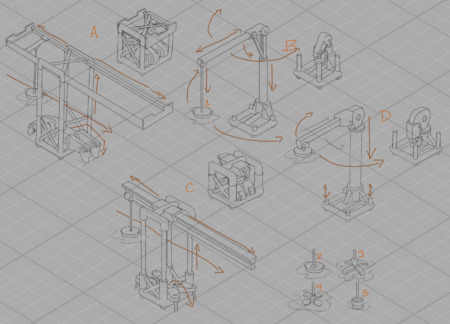
Key elements were: we wanted it to attach securely to the ground, and we wanted the player to feel like they had maximum options when it came to positioning its pickup and dropoff points. With those priorities and with our low-poly 3D outcome in mind, we ended up grabbing the legs from A and putting them on D -- D felt like the most flexible in terms of how far we could spin or stretch the reach of the crane, and also the most simple in terms of modelling and animation challenges. There were further edits and redesigns and tweaks and additional passes on a lot of this stuff -- especially the containers -- but I thought folks might like to see how we approached colour for the equipment! And that's a HUGE question, so I'll be saving that for its own post, alongside the epic journey that colour took while I was on the project. Read the full article
12 notes
·
View notes
Text
✨6/11/23✨




things i did for school today
- studied physics
- finished rendering my 3D model
- did some sketches for tomorrow’s consultation with my design professor
-also made some wire mini models for my studio project
selfcare moments
- went to a classical music concert tonight and it was so amaziiing, i want to do this at least once a month
- met up with my friend i haven’t seen for a long time and we talked about our designs. it was so refreshing and i felt so motivated afterwards
- riding the tram with my music on
- went grocery shopping and bought so much fruit and food that i love
- finally washed my hair and my curls are back! i missed them so much (i’m also thinking of cutting my hair shorter but i’m not sure about it)
what i’m grateful for
- my friends
- music
- good food
- being able to appreciate culture
- coffee shops that are open on a late sunday evening
- being able to draw whatever concept i have in mind
tasks i’d like to do tomorrow
- study physics
- hand in my 3D homework
- read the article which i will base my essay on
- draw one my homework for drawing class because i probably won’t be able to do it on tuesday
- revise all that i’ve learned for physics and prepare myself mentally for the test on tuesday
how i felt today
at first i was a bit disappointed my boyfriend wasn’t able to make it to the concert but i went with a friend from school instead and it was so greaaat. i had such a good time and the music moved me a lot, it was simply beautiful. i was tired the whole day so i can’t wait to sleep but it was all worth it. i also came up with some new concepts for my studio project so i am pretty happy about that, now i just have to convince her to like it too haha.
🎧 how to disappear completely - radiohead
✍🏻 to be free is often to be lonely
peace and love
x
#college#study motivation#study blog#studyblr#uni#uni life#university#art#art study#dear diary#studyinspo#study aesthetic#study notes#student#studyspo#artist#designer#design#digital diary#my diary#diary entry#tumblr diary#diary
16 notes
·
View notes
Text
Design My OC
I’ve been thinking about how to make my OC (Original Character) for a long time.
I will rig it by Live2D if it will be completed someday.
And I wanna make some videos with it though I don’t know I wanna become a Vtuber.
Anyway here is some motif that I wanna add to my OC.
Rose
Long curly hair in pink
Then the design that I drew one year ago is here.

I didn’t decide the color of eyes first.
Actually, I wanted to color them in brown, but I wouldn’t.
Because green gives a sense of color unity in the design.
The reason why is green is same color of the leaves of roses.
So then I decided my OC’s eyes are green.
By the way, I don’t dislike this design but it looks too many frills and too dressy, I feel.
I’m not ladylike actually, haha.
Then I tried to make 3D model by VRoid Studio instead of 2D model.
https://twitter.com/mihayuuno/status/1668937312703741952?s=20

How is it?
I think it looks kinda cute, doesn’t it?

For the outfit, it’s a default materials but added a little editting.
The name Miha and pattern of roses are added on some parts.

VRoid model can be changed outfits easily, so I made Yukata, too.
https://twitter.com/mihayuuno/status/1676163229767327744?s=20
It looks like summer!
I admire VRoid Studio because it’s free and easy to make 3D model.
Here is a article I wrote that how to make VRoid model.
Though it’s in Japanese, I’m glad you would like to read it!
https://www.fanbox.cc/manage/posts/6158899
Now, I’m making 2D model based on the 3D model.
Usually, most people would make 2D model before 3D model...
Hair and face are decided like 3D model, and the problem is the design of outfit.
I’ve been thinking about the outfit for a long long time.
These are the designs that I drew for the time being.
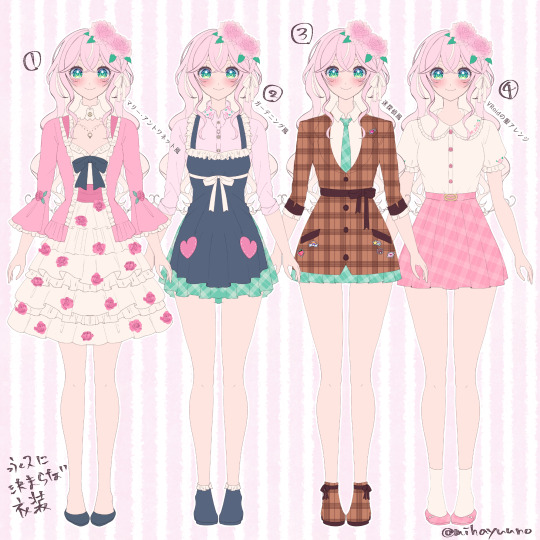
1. like Marie-Antoinette
2. like gardener
3. like detective
4. arranged the VRoid model
Ummm, 2 or 4 is better?
For 2, I drew the illustration before.

For 3, I use it for my icons on some SNS.
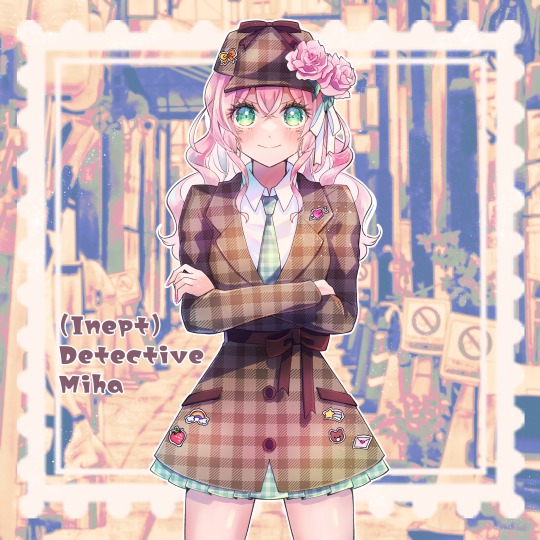
Which one do you like?
Or what design do you want for your OC if you make it?
Can you come up with it quickly?
I’ve been thinking about it a few years.
It’s too long, isn’t it?
I’m gonna show you the complete design if it will be finished.
I will try to draw the design of outfit first!

Thank you so much for reading my blog! Take care💕
12 notes
·
View notes
Text
Imposter Syndrome
One of my favorite things about game development is how circular our history of solving problems is. Take for example, the solution to Wolfenstein's (And later, Doom's) problem of how to display intractable in-world objects, such as weapons, items, and most importantly enemies. Well - all they had was the hammer called 'scaling sprites', so that's what they used; For Wolfenstein 3D they simply made a flat 2D pixellated image larger and smaller. Heck, it worked so well, they could add artistic flair that no real-time renderer could handle for another decade - simulated lighting and shadows to the static painted objects!

[Image of various sprites from Wolfenstein 3D demonstrating the range of different props and environment art]
Doom of course (as it does) turned that up to 11. What if, not only did we scale a sprite according to distance, but also changed the graphics based on the viewing angle such that it was percieved not as a static 2D image but a 3D object. Since the camera could only yaw, there was only a very small amount of directions that needed to be created, and that just might barely fit in the graphics memory budget set aside for this machine.

[Image of all angles of a Cacodemon sprite from Doom]
Again, they were able to surpass the apparent limitations of the hardware they ran on, with higher-resolution images that were (for the time) extremely detailed and realistic. Representing something that impressive again wouldn't have been possible in 3D for another decade.
Even during the 3D revolution of games, the billboarded sprite (a name for this technique) continued to survive - but now not strictly necessary to achieve visuals, merely as an opportunity to gain savings on rendering performance in favor of more important visuals.

[An image of Mario 64 with billboard sprite trees in the background]
This allowed - again, more impressive visuals than models could at the time represent - but also, allowed freeing up polygon budgets for using on more important or detailed objects, like the main character.
Fast forward like 25 years and I'm still seeing people discuss this technique (that is, admittedly much more advanced) as if it's a novel discovery or a recent technique - enough to warrant a GDC talk about it! For example, this article about significant performance improvements in fortnite pretty much re-introduced the idea into the AAA mainstream tech discussion.

[Image of a tree fortnite asset being prepared to be baked as an imposter]
Admittedly, the pipeline is different - automated tools bake out multiple albedo/normal/reflective spritesheets, and many more directions are possible - but the technique is still the same. Never changes. Just like those crazy kids taking pictures of a clay model on a turntable.

[Image of a clay model of the Doom Cyberdemon on a stand, used for digitization into the doom graphical assets]
That's why I love learning about how old games were made - the techniques they used to solve their problems are eternal, and always shockingly relevant to even triple a productions. Sometimes, it's better to read and learn about old wheels instead of reinventing your own.
2 notes
·
View notes
Text
It's interesting because I was just reading this article about the making of Rapsittie Street Kids: Believe in Santa, largely believed to be the worst animated holiday special of all time.
The story goes that the producer had a dream of creating an animated film, but he and his studio did not have the funds needed to hire really skilled 2D animators or animate in 2D, or even to outsource the development to Asia which was the style at the time.
2D animation costs a lot because it's hard fucking work, it takes a long time to get right and thousands and thousands of drawings by a skilled team of many, many people. That's not even counting tweening and coloring and special effects and post and editing and all the drawings that have to be thrown away or get cut. The result can be absolutely incredible and awe-inspiring to look at, but it's not cheap and the artists more than deserve fair pay considering the years you have to put in to get really, really good at it.
Well, this guy decided that in order to have his dream realized, he would have to find a way to slash costs. This was at a time when CGI for animation was still fairly new but not bleeding-edge. Ultimately he set his sights upon a software called 3D Choreographer, which was kind of the 3D equivalent of PowerPoint. I'm talking clip-art tier. This tool had no business being used for animation of any kind, much less for an animated feature.
To make a long story short the limited featureset crippled the production of this special. Apparently the program had no way to import models into it so they paid the developers of the software to create models of the characters and send those files back over. Too bad nobody told the developers of 3D Choreographer how to 3D animate human beings. This is why all of the characters look nightmare-tier. I mean this MIGHT be okay for like, a school project, a demo, something like that. But for an animated Christmas special set to air on the WB featuring the voice talents of not just Mark fucking Hamill, not just Jodi Benson i.e. Ariel the Little Mermaid, but Nancy Cartwright i.e. Bart fucking Simpson???? Bro.
Apparently the producer was very well connected and treated the voice talent right which enabled him to net these star players while just not giving a shit about the animation quality. Which is arguably the most important thing in an animated feature next to, I don't know, the story? Which is pure shit as well.
Anyway they were given a timeline of 4 months to animate a 40 minute special. 4 months. In the 3D equivalent of PowerPoint. With no storyboards. None.
It didn't turn out so good.
The article goes into way more detail about how this came to be but let me tell you, it is fascinating. And it's sad that good 2D animation is no longer valued in the industry as it should be, because it's starting to become a lost art. What I learned from this story is that producers will take any excuse to cut costs. The mistake that these producers made was not understanding the technology, the time estimate, or what they were looking to create. They failed on basically every level, starting with communication with the animators and artists about what they would need to get the project done.
(The only good thing you can say for them is that they did, apparently, compensate the animators fairly. But man, would any of them really want to put this shit on their resume afterward?)
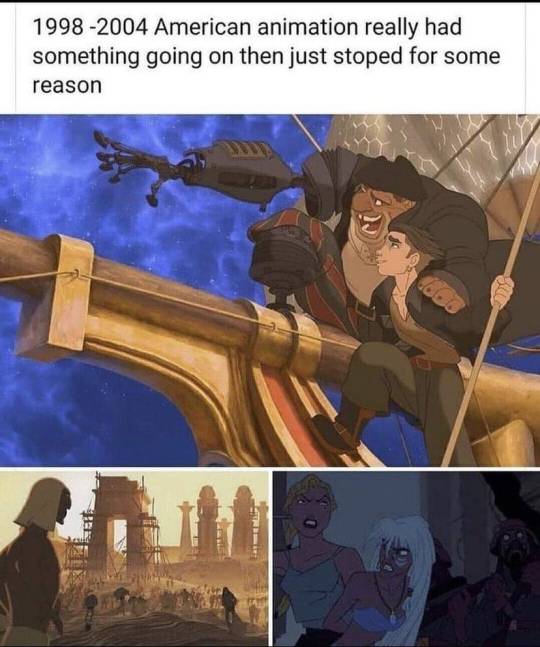
186K notes
·
View notes
Text
The Role of Electrical BIM in Sustainable Building Design

In the current era of environmentally conscious construction, sustainable building design is no longer optional—it’s a necessity. Whether it’s reducing energy consumption, conserving resources, or integrating renewable technologies, sustainability has become the cornerstone of modern architecture and engineering. Among the tools that are driving this transformation, BIM electrical stands out for its ability to optimize efficiency, reduce waste, and enable smarter, greener design decisions across all stages of the building lifecycle.
This blog explores how BIM electrical empowers sustainable design and the vital role that electrical BIM modelers, BIM electrical engineers, and MEP BIM modeling play in shaping a cleaner future for the built environment.
What Is Electrical BIM?
Electrical BIM (Building Information Modeling) involves the creation of intelligent, data-rich 3D models that detail the design, layout, and performance of electrical systems within a building. It allows for comprehensive planning of electrical components like lighting, wiring, conduits, distribution boards, and renewable energy systems.
To better understand the fundamental concepts, refer to our in-depth article:
BIM for Electrical Engineers: Key Concepts Explained
1. Enhancing Energy Efficiency through BIM Electrical
One of the most powerful advantages of BIM in electrical engineering is its ability to simulate and optimize energy consumption before a single wire is installed.
Energy modeling and simulation: With BIM tools, BIM electrical engineers can simulate how different lighting designs or power layouts will perform. These simulations offer insight into load distribution, energy usage, and potential inefficiencies.
Lighting control optimization: BIM models support advanced design for energy-saving systems like motion sensors, dimmable lights, and daylight-responsive lighting—critical elements in achieving LEED or BREEAM certification.
Load balancing: Accurate BIM modeling allows for smarter load distribution and sizing of electrical systems, which helps avoid overspecification and cuts energy waste.
Smart metering integration: Energy meters and sensors can be included in the bim electrical model to support energy tracking in real-time, both during and after construction.
For a deeper dive into how MEP systems can directly impact building performance, read:
How Do MEP Design and Drafting Improve Building Efficiency?
2. Resource Optimization and Material Waste Reduction
Beyond energy, BIM for electrical engineers helps make smarter use of physical materials—cabling, fixtures, panels, and more.
Accurate quantity take-offs: A major benefit of MEP BIM modeling is precise material estimation. With detailed information about every conduit, fixture, and cable run, engineers can reduce overordering and minimize on-site waste.
Just-in-time delivery and lean construction: By aligning model data with scheduling tools, materials can be delivered exactly when needed, preventing unnecessary storage and deterioration.
Reduced rework through clash detection: Through clash detection, conflicts between electrical systems and HVAC, plumbing, or structural elements are identified before installation begins. This prevents time-consuming and wasteful corrections during construction.
Lifecycle material tracking: Components modeled in BIM electrical can be tagged with lifecycle data, helping stakeholders evaluate environmental impact and recyclability.
3. Integration of Renewable Energy Sources
Sustainable building isn’t just about consuming less—it’s about generating clean energy. BIM makes it easier to plan and integrate renewable systems such as solar panels, EV charging stations, or wind turbines into a building’s electrical infrastructure.
Site-specific solar panel planning: With geolocation data and solar analysis tools, electrical BIM modelers can optimize panel placement, angles, and connections to maximize energy generation.
System interoperability: BIM enables coordination between renewable systems and conventional grid-based electrical networks, ensuring safe, reliable, and efficient operation.
EV charging infrastructure: As electric vehicles become the norm, BIM can model and validate EV charging systems’ load impact and compatibility with the building’s energy management systems.
Battery storage modeling: Future-ready electrical designs include energy storage systems, and BIM helps plan for their integration in mechanical rooms or rooftops.
Learn more about innovations in this area here:
What Are the Future Trends in Electrical BIM Modeling Technology?
4. Promoting Lifecycle Sustainability
Unlike traditional design tools, bim electrical is not just useful during construction—it continues to deliver value for decades.
Maintenance and operations: Facility managers can use BIM models to locate electrical assets, access component data, and schedule predictive maintenance, extending equipment life and reducing unexpected downtime.
Decommissioning and recycling: BIM provides insights into the disassembly and material recovery process at the end of a building’s life, supporting circular economy principles.
Building performance analytics: Post-occupancy evaluation is possible by linking BIM data with performance monitoring tools. This feedback loop helps architects and engineers improve future designs.
5. Enabling Multidisciplinary Coordination in Sustainable Design
Modern sustainable buildings require seamless collaboration between multiple disciplines. BIM in the AEC industry fosters cross-functional coordination like never before.
Centralized model: Architects, HVAC engineers, structural designers, and BIM electrical engineers all work in the same federated model, reducing delays and information silos.
BIM coordination meetings: Weekly or biweekly model coordination sessions ensure that sustainability goals are maintained as the design evolves.
BIM execution planning (BEP): BEPs often include sustainability KPIs—ensuring that electrical systems contribute to the building’s broader environmental objectives.
Compliance and certification: BIM data can directly support certification requirements for green building standards like LEED, WELL, and IGBC.
Conclusion
The shift toward sustainable building design is accelerating, and BIM electrical is at the forefront of this transformation. From improving energy efficiency and resource optimization to enabling renewable energy integration, BIM empowers electrical BIM modelers and BIM electrical engineers to design smarter, greener buildings.
Sustainability is not a trend—it’s a responsibility. And the digital tools we choose today will define how efficiently we build tomorrow.
At SmartCADD, we are committed to helping organizations embrace the full potential of BIM in electrical engineering. Whether you’re starting a new project or looking to retrofit an existing one, our expertise in MEP BIM modeling, clash detection, and sustainable design can guide you every step of the way.
#bim electrical#electrical bim modeler#bim electrical engineer#mep bim modeling#bim for electrical engineers#bim in electrical engineering#bim#BIM in AEC Industry#clash detection
0 notes
Text
How fast is 3D printing?
How fast can 3D printing be? In what scenarios can it really bring the dual advantages of speed and cost? This article will compare mainstream 3D printing technologies (such as FDM, SLA, SLS, MJF) with traditional processes (such as CNC, injection molding, casting), combined with typical production scenarios, to dismantle the technical core and commercial significance of "3D printing speed" for you.
I believe that after reading this article, you will have a clearer answer to "when to use 3D printing and why it is so fast and meaningful".
Fast 3D Printing vs. Traditional Crafts: Which is Faster?
Before we compare specific technologies, let's clarify a basic issue: FDM (fused deposition modeling), SLA (stereolithography), MJF (multi-jet fusion), these names are all different molding principles of 3D printing. They each have their own unique printing methods, material adaptability and speed performance, so they have their own advantages in efficiency. In sharp contrast to them, traditional manufacturing processes such as CNC, injection molding, and casting also have completely different production capacity structures and response rhythms. Let's disassemble them one by one to see whether 3D printing technology can catch up in terms of speed.
FDM vs. CNC
When you need to make a small tool sample urgently (for example, wThe advantage of this technology lies not only in its speed, but also in its flexibility. In particular, after adjusting the nozzle diameter (such as above 0.6mm), the nozzle speed can reach 150 mm/s, and a medium-complex part with a height of 100mm can be printed within 1 hour. FDM has obvious advantages in printing speed, which can significantly improve molding efficiency and is suitable for rapid prototyping and testing of medium-complexity prototypes.hen the design is completed at 3 pm and the installation verification is required in the evening), FDM (fused deposition modeling) technology will be the best solution.
But if it is changed to CNC, the delivery time is often measured in days due to the preparation of process documents, debugging of tool fixtures, and cutting process.
SLA/DLP vs. Injection Molding
SLA (stereolithography) is known for its high precision, with a layer thickness of 0.025–0.1 mm, an accuracy of up to ±25μm, and a molding speed of about 10–30 mm/h. The advantage of SLA printing speed is not its high speed, but its ability to output stably while maintaining surface quality, which is suitable for scenes with high requirements for process consistency.
DLP (digital light processing) is more efficient in printing. It increases the printing speed to 50-100 mm per hour by exposing the entire layer of the image at the same time, which is particularly efficient in the production of small-sized and large-quantity parts. The advantage of DLP printing speed is that it can quickly respond to batch requirements. It keeps a certain degree of accuracy while minimizing the unit molding time.
In contrast, although injection molding is very fast in single-piece molding speed, its overall delivery cycle is often extended by the pre-process of "mold development", which usually takes several days or even weeks and is accompanied by high costs. If the product design is frequently adjusted, the trial and error cost of repeated mold changes will also be very high.
SLM vs. Metal Casting
The biggest feature of SLM is that it can print complex structures in one go - for example, parts with through holes, buckles, and grids, without any support. Since SLM does not require mold opening and prefabrication processes, it can significantly speed up the overall delivery speed in the early stages of product development.
In contrast, although metal casting has cost advantages in mass production, the preparation process is long - mold design, casting cooling, and deburring often take several days or even a week. If you encounter a business scenario that requires rapid iteration, metal casting technology is basically unsolvable.
How fast 3D printing wins in three major scenarios with speed
In addition to the differences in the technology itself, the advantages of 3D printing speed also vary in different practical scenarios. From R&D proofing to mass production, we take a panoramic look at its actual performance at the application level.
Rapid prototyping
In the early stages of hardware product development, whether or not samples can be produced within a day often determines the efficiency of project iteration. Compared with traditional manufacturing that requires production scheduling, mold making, and debugging, 3D printing can achieve same-day design and same-day delivery. FDM printing is suitable for structural verification and preliminary testing, while SLA can achieve high-quality appearance models with a resolution of ±25μm. No mold is required, and samples can be produced directly, which is the biggest speed advantage of 3D printing in the prototype stage.
3D printing technology understands that prototype verification is not a one-time delivery, but a cycle mode of rapid trial and error-instant correction to promote continuous product evolution. Making trial and error fast and low-cost is the key force that 3D printing technology gives to the rhythm of product development.
Small batch custom production
When products pursue personalization and frequent iterations, the mold development and assembly processes of traditional manufacturing often cannot keep up with the pace. 3D printing technologies such as MJF and SLM do not require mold opening and can directly print finished parts. Taking MJF as an example, the industrial model has an hourly output of more than 3,000 cm⊃3;, which is suitable for typical scenarios such as orthopedic brackets and customized shells.
The key to small-batch customization is not the unit cost, but the response speed of delivery and the freedom of design. 3D printing provides a new generation of flexible manufacturing path.
Large-scale standardized production
Although injection molding and CNC still dominate in mass manufacturing, 3D printing is becoming an accelerator for early verification. In the stages of new product trial sales and regional testing, 3D printing can deliver hundreds of samples within a few days, seize the market time window, and reduce the risk of repeated mold modifications.
In mass manufacturing, 3D printing is not a substitute, but an accelerator. It helps companies quickly try and fail in uncertainty and make more informed judgments before formal mass production.
In an era where manufacturing efficiency has become a competitive threshold, the speed dividend of 3D printing has moved from prototypes to mass production, from innovation to profits. It can not only fill the response window of traditional processes, but also provide a decision buffer in uncertainty. The question is not whether 3D printing can be used, but when it is most cost-effective to use it. The following table summarizes the performance of various manufacturing methods in terms of speed, flexibility and cost under different production goals, helping you to judge at a glance:

3D printing is not the opposite of traditional manufacturing, but a powerful complement to it. From rapid prototyping, flexible trial production to product verification, it allows companies to conduct trial and error quickly and at low cost, speeding up the pace of every idea to implementation. This is exactly the key point mentioned at the beginning of the article: the real manufacturing advantage does not lie in how fast the machine runs, but in whether you can use "speed" on the blade of innovation at the right time.
Want to learn more about which 3D printing solution is best for your product design or production line? Contact us for a free consultation.
1 note
·
View note
Text
Scaling Oral Health Prevention with AI-Driven Caries Detection

Early identification of decay can transform oral health outcomes. As AI-powered cavity detection systems mature, they promise faster screenings and fewer false negatives. Advanced algorithms analyze radiographs and intraoral scans to flag minute lesions that escape human eyes, accelerating intervention and reducing long-term treatment costs.
Enhanced Imaging Integration
Combining machine learning with high-resolution digital radiography and 3D intraoral scanners enables real-time analysis. Next-generation platforms will fuse multiple image sources—X-rays, optical scans, and fluorescence data—to improve diagnostic accuracy. Dental practices can upgrade existing equipment with AI modules, avoiding large capital outlays.
Mobile and Remote Screening
Smartphone attachments and cloud-based analysis apps are expanding access beyond clinic walls. Employers can host on-site screening days using portable intraoral cameras linked to AI engines. Employees receive instant feedback through secure portals, promoting early care and reducing absenteeism due to dental emergencies. Relieve tooth pain with root canal in Whyalla—Schedule your appointment now!
Predictive Risk Assessment
Future systems will harness patient history, dietary logs, and genetic markers alongside imaging. By modeling decay risk trajectories, AI can recommend personalized recall intervals and preventive measures. Businesses with dental benefit programs can integrate these insights into wellness platforms, tailoring incentives for employees who maintain risk-based checkups.
Chairside Near-Infrared Detection
Emerging chairside tools use near-infrared transillumination combined with AI to detect demineralization beneath enamel surfaces. These devices provide immediate visual maps of at-risk areas during routine exams. Clinics offering this technology can market “painless early detection,” attracting health-conscious patients and corporate groups seeking premium care.
Practical Implementation Strategies
To stay ahead, businesses should partner with dental technology vendors offering scalable AI solutions. Pilot programs for employee health fairs showcase on-site screenings and generate usage data. Training designated office champions to coordinate appointments and follow-up communications ensures consistent participation and positive experiences.
Expert Insights for a Healthier Workplace
Dr. Anita Patel, a specialist in dental informatics, notes that “integrating AI screenings into wellness programs yields a 30% reduction in emergency dental visits.” Employers report improved morale when staff feels supported by preventive health measures. Publishing anonymized success metrics—such as reduced sick days—reinforces program value to stakeholders.
Embracing AI-powered cavity detection not only elevates diagnostic precision but also underpins robust corporate wellness strategies. By deploying imaging upgrades, mobile screening tools, and predictive analytics, businesses can foster a healthier workforce, lower benefits costs, and position themselves as innovators in employee care.
Read more articles about Wisdom Teeth Removal Whyalla here at - https://websarticle.com/patient-insights-dental-prosthesis-implants-or-traditional-dentures/
0 notes
Text
The Essential Guide to Clothing Fabric Swatches in 2025
In the ever-evolving world of fashion and textiles, 2025 marks a significant leap forward in the way we source, understand, and utilize fabrics. Whether you're a fashion designer, tailor, interior decorator, or simply a fabric enthusiast, having access to fabric swatches is a critical step in choosing the right material. Fabric swatches allow for hands-on inspection of texture, color, weight, and quality—details that digital images can never fully convey.
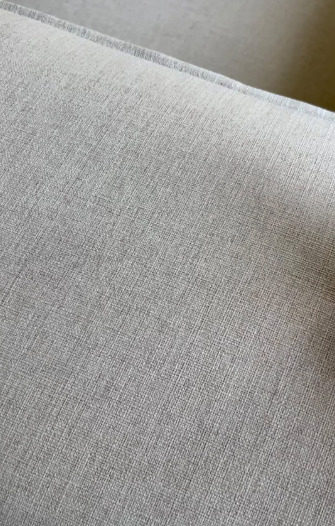
In this Essential Guide to Clothing Fabric Swatches in 2025, we’ll walk you through everything you need to know about fabric swatches in today’s market—from what they are and why they matter to how innovations are shaping their future. Whether you're shopping online or sourcing for a large-scale design project, this comprehensive guide is your key to making confident and informed fabric choices.
Read the original article on Klekktic
What Is a Fabric Swatch?
A fabric swatch is a small sample of textile material used to showcase the characteristics of a larger fabric roll or bolt. Typically measuring around 4”x4” to 8”x8”, swatches are often cut directly from the original material, preserving its true texture, weave, and finish.
Fabric swatches are not merely marketing samples—they are essential decision-making tools. They allow professionals and customers to feel the texture, examine color accuracy in real light, test stretch, opacity, and evaluate overall quality.
Why Fabric Swatches Matter in 2025
The fashion and textile industry is undergoing rapid transformation, led by digitization, sustainability, and increasing customer expectations. Here's why fabric swatches remain indispensable in 2025:
1. Tactile Experience
Even in the era of 3D modeling and AR shopping, nothing replaces the sense of touch. Fabric swatches give buyers the ability to physically feel softness, coarseness, sheen, or stiffness—qualities that define a material’s wearability and suitability.
2. Accurate Color Matching
Digital screens can alter the appearance of fabric colors depending on calibration, brightness, and contrast. A swatch provides real-world color accuracy, allowing for better coordination with other design elements.
3. Material Transparency
Fabric swatches can reveal whether a fabric is breathable, see-through, structured, or flexible. This is crucial for applications such as apparel design, upholstery, or curtain-making.
4. Eco-Conscious Sourcing
Many sustainable brands now offer swatches of organic or recycled materials. This allows designers to test ethically sourced fabrics before committing to bulk purchases—minimizing waste.
The Evolution of Fabric Swatches: Then vs. Now
Then (Pre-2020)
Historically, fabric swatches were available only in physical fabric stores or through swatch books shared by textile sales reps. Access was limited and usually part of business-to-business interactions.
Now (2025)
With the rise of e-commerce and virtual showrooms, online swatch ordering has become the norm. Consumers can now:
Order swatches from anywhere in the world
Choose swatches based on AI-powered recommendations
View digital previews before ordering physical samples
Track sourcing history and eco-certifications
Compare fabric durability and sustainability ratings
Brands like Klekktic are leading the way in modernizing the swatch ordering process, offering quick delivery, curated selections, and eco-conscious choices.
Types of Fabric Swatches in 2025
Fabric swatches vary not only by material but also by usage. Understanding the different types will help you select the right swatches for your needs.
1. Woven vs. Knit Swatches
Woven swatches offer structured, non-stretch fabrics such as denim, poplin, or tweed.
Knit swatches demonstrate stretch and are used in activewear, T-shirts, and intimates.
2. Natural vs. Synthetic Fibers
Natural fibers: Cotton, wool, silk, linen, hemp.
Synthetic fibers: Polyester, nylon, rayon, acrylic, spandex.
3. Blended Fabric Swatches
These combine multiple fibers for enhanced functionality. Example: Poly-cotton blends that mix durability with breathability.
4. Specialty Swatches
Includes fabrics like:
Smart textiles (heat-sensitive, conductive)
Waterproof laminates
Eco-friendly swatches (bamboo, recycled PET)
How to Use Fabric Swatches Effectively
To make the most of your fabric swatches, consider these practical steps:
1. Create a Mood Board
Pin swatches onto a board along with your design sketches and color palette. This gives a visual and tactile overview of your concept.
2. Test in Natural Light
Evaluate the swatch in daylight, as artificial lighting can distort color and texture.
3. Perform Wash & Stretch Tests
Some suppliers allow extra swatches for stress testing. Try washing, drying, or stretching them to observe shrinkage, fading, or pilling.
4. Pair with Trims and Accessories
Bring trims, buttons, and zippers alongside your swatches to test compatibility.
5. Track Swatch Details
Note down each swatch’s specifications—fiber content, weight (GSM), weave, origin, care instructions, and price.
Where to Get Fabric Swatches in 2025
Sourcing swatches has never been easier thanks to textile innovation and digital accessibility. Here are top platforms and methods:
1. Online Marketplaces
Brands like Klekktic offer curated swatch collections.
Online catalogs let users order swatches with one click.
2. Swatch Subscription Services
Monthly swatch boxes deliver the latest fabric innovations directly to your door, ideal for designers and students.
3. Fabric Libraries
Institutions and fashion schools often maintain libraries of swatches, categorized by season, trend, or utility.
4. Trade Shows & Textile Fairs
Global expos like Premiere Vision Paris and Texworld provide swatch samples from international mills and producers.
Smart Fabric Swatches: The Future of Sampling
The integration of technology with textiles is revolutionizing how we use fabric swatches. In 2025, cutting-edge options include:
1. QR-Enabled Swatches
Each swatch includes a QR code that links to full digital specs, supplier information, origin traceability, and order forms.
2. Augmented Reality Swatch Apps
With AR, users can overlay swatch textures onto digital clothing models to preview how the fabric will behave in motion.
3. Sustainable Tracking
Blockchain-enabled swatches offer verified data on:
Carbon footprint
Water usage in production
Worker welfare at source
These innovations support transparency and ethical sourcing.
Sustainability and Swatches: A New Standard
As eco-awareness grows, swatches have become central to sustainable design workflows. Here’s how:
1. Minimal Waste
Ordering swatches before bulk purchasing helps avoid overproduction and unused fabric waste.
2. Sustainable Packaging
2025 sees most swatch services using compostable mailers or recyclable packaging.
3. Digital-First Sampling
Many companies offer digital swatch previews to reduce unnecessary physical samples—reserving fabric production for confirmed orders.
Benefits of Ordering Swatches Before Full Purchase
✔️ Confident Decision-Making
Swatches eliminate guesswork and avoid costly mistakes in bulk orders.
✔️ Improved Fit and Function
By testing material behavior (stretch, drape, resistance), designers ensure that the end product will perform as expected.
✔️ Time-Saving
Quick swatch decisions speed up the design cycle and production timeline.
✔️ Professional Presentation
Swatch samples enhance client presentations, helping them visualize the finished product.
Use Case Examples
Fashion Designers
Designers can test how satin drapes for evening wear or if jersey blends are breathable enough for activewear.
Interior Decorators
Upholstery swatches help in choosing the right texture and durability for furniture.
Home Sewers
DIY crafters use swatches to pick fabric suitable for quilting, curtains, or custom garments.
Menswear Brands
Fine suiting brands rely on wool and linen swatches to curate seasonal collections.
How Klekktic Is Leading the Swatch Movement
Klekktic has become a go-to platform for designers and consumers looking for premium, sustainably sourced fabric swatches.
Features of Klekktic Swatches:
Free or low-cost sample options
Curated collections by theme or trend
High-quality photography with digital previews
Transparent origin and material descriptions
Fast global shipping
Klekktic simplifies the sampling process while supporting ethical design values—making it easier than ever to bring your fabric vision to life.
Conclusion: The Swatch Is Here to Stay
As we move deeper into 2025, fabric swatches are not just a convenience—they're an essential tool for anyone working with textiles. From improving customer confidence to ensuring ethical practices, swatches bridge the gap between creativity and practicality.
Whether you're a budding designer or an experienced producer, using swatches effectively can elevate your projects, protect your budget, and align with modern values of transparency and sustainability.
To learn more and explore premium swatches, visit the full guide on Klekktic.
FAQs About Fabric Swatches in 2025
1. What is the standard size of a fabric swatch?
Most swatches are 4”x4” to 8”x8”, but sizes can vary depending on the supplier and fabric type.
2. Are swatches free?
Some suppliers, like Klekktic, offer free swatches for limited selections. Others may charge a nominal fee to cover shipping and handling.
3. Can I return fabric swatches?
Generally, swatches are non-returnable, but policies vary by company.
4. How many swatches should I order?
It’s best to order at least 3–5 swatches for comparison before committing to a larger purchase.
5. Are there eco-friendly swatches available?
Yes. Many brands now offer swatches made from organic, recycled, or low-impact materials.
6. Do swatches match the final fabric?
Swatches are cut from the same roll as the final product. However, there may be slight dye lot variations over time.
7. How long does it take to receive swatches?
Delivery can take anywhere from 2 to 14 days, depending on the location and supplier.
8. Can I use swatches for small craft projects?
Yes! Leftover swatches can be repurposed for patchwork, DIY crafts, or sampling.
9. What’s the difference between a swatch and a sample yard?
A swatch is a small square, while a sample yard is a full-length fabric piece often used for test sewing.
10. Where can I learn more about fabric swatches?
Visit Klekktic’s essential guide for more insights and ordering options.
0 notes